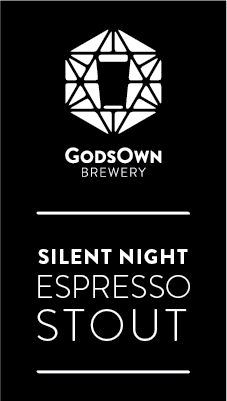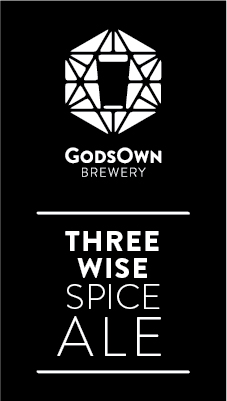Winter Range
M
Silent Night Expresso Stout
“We will drink your health both in stout and best wine” was stated in a letter from 1677 and is the earliest recorded use of the word “stout”. Compared to porter, Stout is better known and more widely available. At the time of 1677 it appears that stout was a bit of a jargon meaning simply “strong beer” and this reference can’t be discounted as in fact the first stouts were in fact just strong porters.
Novel additions were made in the history of adulteration from stout porter known as “butt beer” in the 1800s with the additions of milk sugar (lactose), oatmeal and even oysters. These extras, to name a few, were added to bolster the beer’s position as a nutritional or health supplement. The health perception of stout was so strong that it continued into the middle of the twentieth century when doctors prescribed a pint or 2 a day even in hospital.
There are many different categories of stout such as dry, sweet, oatmeal, foreign extra, tropical, American and Russian Imperial, etc. They also lend themselves wonderfully to the addition of many other types of wonderful adjuncts, such as treacle, molasses, liquorice, cloves, cassia, rosemary, black pepper, grains of paradise, coriander, cocoa, nutmeg, ginger and the list goes on and on. But our favourite is Coffee.
Using the cold toddy method we brew up some freshly ground coffee and add during the whirl-pooling prior to cast-out. This adds all the wonderful flavours of freshly ground espresso coffee. This combined with our fusion of a sweet and oatmeal stout delivers a roasted and oatmeal aroma with the sweet espresso coffee and chocolate notes. Medium-full bodied and creamy with the silkiness and richness from the oatmeal.
Grain Bill: Pale Malt, Pale Wheat, Medium Crystal, Chocolate, Roasted Barley, Flaked Maize and Oatmeal
Hop Bill: Horizon, Willamette and Cascade
Adjuncts: Espresso Coffee
Yeast: Safbrew S-33
Year: 2016/2017
OG: 1.070 FG: 1.030 IBU: 30 ABV: 5.6%

3 Wise Spice Ale
This is another spice beer release for the colder months and falls into the SHV (Spiced, Herb or Vegetable) beer category. It is reminiscent of the Christmas (in July) ginger bread, puddings and mulling spices. It will warm the body and soul.
Our grain bill has a unique GodsOwn made Crystal malt that has been produced in our pizza oven. This brings through its own unique rich flavour and colour to the malty base. We have called it the 3 Wise Spice because the spices used, we believe, pay homage with joy for any festive reason. If you like the Garden of Eden, we are sure you will like the 3 Wise Spice Ale. It finishes full, satisfying and warming with a good balance between the spices and hops and is suggested as a good accompaniment for evenings by the fire.
Grain Bill: Pale Malt, Dark & GodsOwn Crystal, Caramunich, Pils and CaraPils Malt
Hop Bill: East Kent Goldings, Hallertau Tradition and Santiam
Spice Bill: Ginger, Orange Peel and Cinnamon
Yeast: Safbrew T-58
Year: 2016
OG: 1.069 FG: 1.016 IBU: 30 ABV: 6.9%

Big Bang Brown Ale
The words “mild” and “brown” are two of the oldest terms used to describe English beers and are still in use today. The earliest of English beers are believed to be brown in colour as they would have been made from malt that was brown and smoky as a result of the kilning over a hardwood fire.
The smokiness derived from oak, beech or hornbeam was itself a prized characteristic of the day. It was not until the development of coal fires that this smoky flavour was removed. The term brown malt is still seen, although it is rarely produced and no longer smoked.
In the 17th century brewers would often draw more than one wort run-off from a single mash, where the first run-off was referred to as “stout beer” and the second as “Stich or Strong Brown Ale”. Together, these events led to the use of the umbrella term “brown beer”, to identify porters and stouts of all types and distinguish them from pale beers using pale malt.
The dark beers were confined to London due to the realities of production because of the mineral water profile and considered heavy and glutinous. Also, the industry of England created a large labouring class in need of heavy, dark beers that provided sustenance and nutrition.
During the same time a mixture of stale, mild and pale known as three-threads was prepared by the publicans and one of the three beers initially used to prepare this popular London beverage was referred to as a “mild”.
Later in the 19th century the term “mild ale” was used to describe a number of products that were sold fresh and this lack of aging (staling) was a key distinction between these beers and other pub offerings of the day.
Today there is more than one recognised beer substyle for the brown ale, namely London or Southern English Brown ale, Northern English brown ale and American (or sometimes Texas) brown ale.
The main distinguishing differences between these substyles is the malt body profile with respect to colour, flavour, aroma and the hop balance and bitterness. The British substyles are not as hoppy as the American browns. They traditionally only use English hops and tend to be a malty, brown caramel-centric ale without the roasted flavours of a porter. The bitterness ranges between 15 to 25 IBU with the Northern Brown being the hoppier of the substyles.
The American browns have a moderate to medium maltiness but with a greater range of bitterness, ranging from 25 to 60 IBU and traditionally using American hops.
Our Big Bang Brown Ale is a mash-up of the British and American styles. Using all NZ malts (including Brown) to deliver a British malt to hop profile with respect to body and bitterness but utilising both English and American hops. Resulting in a complex sweet, nutty and toasty aroma and character with a moderate hop bitterness.
Grain Bill: Pale Malt, Medium Crystal, Brown, Amber, Chocolate, Black Patent and CaraPils
Hop Bill: Chinook, Willamette and East Kent Goldings
Yeast: Safale S-04
Year: 2017
OG: 1.059 FG: 1.014 IBU: 36 ABV: 5.4%